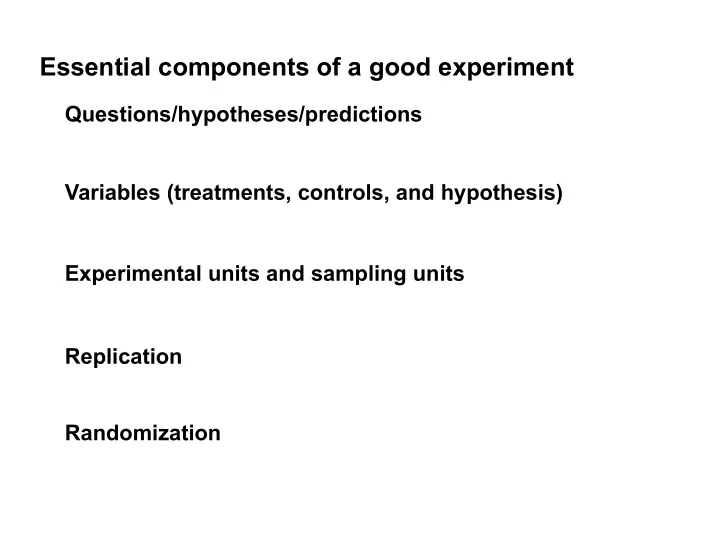

Essential components of a good experiment Questions/hypotheses/predictions Variables (treatments, controls, and hypothesis) Experimental units and sampling units Replication Randomization
Questions, hypotheses, and predictions Make questions and hypotheses as specific as possible Use prior knowledge to pair questions with predictions What is the optimal aging temperature and duration for a washed-rind cheese? How do different strains of Geotrichum impact bitter flavor intensity in a bloomy-rind goat milk cheese? What ripening paper provides best shelf-life and flavor profile of a bloomy-rind cheese? How does washing frequency impact the abundance of Mucor on a washed-rind cheese? What microbe is causing my natural rinds to turn black?
Variables Treatments: manipulated variables that are thought to drive hypothesized response Controls: variables with no treatment applied and an expected outcome Responses: measurements that are used to assess Leclercq-Perlat, M-N., Mariette Sicard, Nathalie Perrot, Ioan-Cristian Trelea, Daniel Picque, and hypothesis and answer Georges Corrieu. "Temperature and relative humidity experimental question influence the ripening descriptors of Camembert- type cheeses throughout ripening." Journal of Dairy Science 98, no. 2 (2015): 1325-1335.
Controls are essential to discern treatment effects In same experiment where a treatment is applied, it is essential to have a ‘standard’ group with no treatment If control group is not possible, comparing to some well-defined baseline can suffice Hay, Christopher J. "The effect of humidity controlled environment on Stilton cheese." International Journal of Dairy Technology 70, no. 4 (2017): 602-606.
Experimental units and sampling units How much sampling within individual cheese unit (wheel) is needed to capture within product variability? What are best time points to measure responses?
Randomization of treatments Takes into account variation in factors that cannot be easily controlled Variation in environment (heat, moisture, etc.) in make room or aging space
Replication of treatments Ensures that observed treatment differences are not due to inherent variability within a system Experimental replication Technical replication Experiment 3 Experiment 2 Experiment 1 Treatment 2 Treatment 1
Example of cheese experimental design
Example of cheese experimental design “The aim of this work was to study the influence of three different variables on the sensory quality of Camembert-type cheese: type of lactic bacteria, type of Penicillium molds, and inoculation method.” B.D. Galli et al., International Journal of Food Microbiology, 234 (2016) 71–75
Example of cheese experimental design B.D. Galli et al., International Journal of Food Microbiology, 234 (2016) 71–75
Have you tried experiments in your cheese facility? What questions did you ask? How did you design your experiment(s)? What challenges did you face in designing or executing your experiment(s)?
Recommend
More recommend